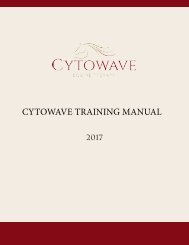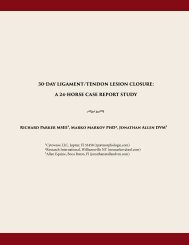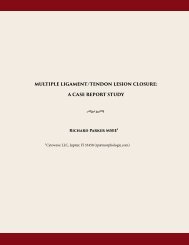Wellington Equestrian cover Feb - March
You also want an ePaper? Increase the reach of your titles
YUMPU automatically turns print PDFs into web optimized ePapers that Google loves.
16 | Henry Schein Animal Health ph: (855) HSAH-EQ1 (472-4371) | fx: (888) 329-3861 | www.henryscheinvet.com<br />
WELLINGTON EQUESTRIAN // FEBRUARY-MARCH<br />
Developing<br />
AN EQUINE MEDICAL DEVICE<br />
Richard Parker developed a theory on what signals the<br />
body produces when it heals itself.<br />
In 2004, Richard Parker found himself surrounded<br />
by the best and brighest minds in<br />
electromagnetic research. He started to look<br />
at the research from a physics perspective<br />
and by going through the biophysics he developed<br />
a theory about healing. “That thinking<br />
resulted in a test and we theorized that a guiding<br />
signal determines how the body repairs itself.”<br />
Richard filed for the patent in 2006 and it<br />
was granted in 2008. The patent office filed the<br />
patent without any reservations and they did<br />
not challenge any of the claims, which is unusual.<br />
“The patent office went so far as to say that<br />
this represents a new science which I was quite<br />
pleased to see. And so therefore, there is only<br />
one patent on this technology.”<br />
The body generates certain electromagnet-<br />
ic signals which are unique to either a healthy<br />
tissue or an injury. Richard’s theory was that if<br />
he took the difference between the healthy and<br />
injured signals, it represented what the body was<br />
producing to heal itself. “It’s a complex mathematical<br />
process to derive this signal and it’s perfectly<br />
logical. Remember the body operates on<br />
the basis of electrochemical reactions and this<br />
always involves ionic transfers through cellular<br />
membranes. This generates a magnetic field by<br />
pricinicples of electromagnetics. “ In laymans<br />
terms, Richard found a way to detect, isolate,<br />
store and then amplify the signal. To obtain<br />
these signals, Richard had to utilize a SQUID machine,<br />
which is capable of detecting electromagnetic<br />
signals down to the cellular level. “Basically<br />
we’re amplifying the signal to accelerate healing.”<br />
OBSTACLES<br />
THE BIGGEST HURDLE IS HUMAN NATURE<br />
When a trainer or owner is asked why they use a certain modality,<br />
one of the most common responses at the race track is “we’ve<br />
been doing it this way for thirty years.” Which cuts right to the<br />
heart of the matter - those who don’t evolve are typically left behind.<br />
“It’s one thing not to embrace change - we get that,’ said Tina<br />
Browne, “but to not even listen is what fascinates me. Here we<br />
have a product that can change how equine injuries are treated.<br />
But many times a trainer won’t take the time to listen because<br />
they believe that there isn’t anything wrong with outdated thinking.”<br />
Chalk this up to human nature. Humans don’t like to change<br />
behaviors, even when it is demonstrated that that change can be<br />
beneficial. “Ultimately, when everyone else is using Cytowave,<br />
they’ll be forced to step up and give it a try.”<br />
Special Feature • Cytowave<br />
Cytowave – A new medical therapy technology<br />
Reliably reduces re<strong>cover</strong>y times from serious tendon and ligament injuries by 5 months<br />
By Richard Parker, Chief Technical Officer, CytoWave<br />
Cytowave is a patented,<br />
non-invasive treatment based<br />
on tissue specific signals.<br />
While other devices in the<br />
equine market use generic<br />
electromagnetic waveforms,<br />
Cytowave offers a tissue<br />
specific analytic method<br />
based on the biology of<br />
the injury. The tissue signal<br />
is derived based upon the<br />
difference in biomagnetic<br />
signals from normal and<br />
injured tissues. This<br />
proprietary SQUID Therapy<br />
Signal (STS) is amplified and<br />
delivered via a mild magnetic<br />
field. This new technology<br />
has been embraced by many<br />
top veterinarians and is being<br />
used as an adjunct to stem<br />
cell therapy or PRP.<br />
“We’ve used Cytowave<br />
most effectively for<br />
tendon injuries, some<br />
suspensory branch<br />
injuries, it’s been very<br />
helpful.”<br />
— Dr. Tim Ober,<br />
United States <strong>Equestrian</strong> Team<br />
http://bit.ly/EQS2015Summer<br />
The Basics of CytoWave Technology<br />
Equine tendon and ligament injuries occur frequently in both competitive and companion<br />
animals. Unfortunately, this type of trauma does not lend itself to fast, non-invasive re<strong>cover</strong>y<br />
techniques. Disorders of these tendons often become chronic and are difficult to manage<br />
successfully. In most cases, re<strong>cover</strong>y is prolonged for many months and even years.<br />
It is theorized that the mechanism for accelerating the closure of ligament and tendon lesions<br />
is found in the nature of the electromagnetic signals impressed on the subject. The specific<br />
and complex activity known as the “healing process” is an expression of the local activity of<br />
electromagnetic fields, as their generation is spontaneous and inevitable due to ionic and<br />
charged particle flow.<br />
CytoWave Therapy technology takes<br />
an actual electromagnetic signal<br />
given off by the body at an injury site,<br />
stores and then amplifies that signal<br />
before re-admitting to the subject so<br />
as to accelerate the healing process.<br />
This “jump-start” occurs because<br />
the signal applied to the injury is very<br />
similar to the same signal the horse<br />
produces. That signal, therefore, is<br />
readily accepted on a cellular level<br />
and processed in such a manner as Opposing coils held by a boot apparatus deliver<br />
the CytoWave STSTM signal<br />
to accelerate the re<strong>cover</strong>y.<br />
Thus, we have a targeted, tissue specific physical therapy which can be used for soft (muscle<br />
and nerve), dense (tendons and ligaments) and hard (bone splinters or hairline fractures) tissue<br />
injuries.<br />
Cytowave derived signals contrasted with the much older PEMF technology.<br />
Simple older PEMF signals<br />
very common in the industry<br />
Actual physiological waveform<br />
which looks nothing like PEMF<br />
Cytowave signals from actual<br />
measurements accelerating repair<br />
These signals have been reported to operate about four times faster than PEMF systems and<br />
obtain consistent results in the 90% range; instead of the 60% range such as is the case with<br />
other popular technologies. As Cytowave uses tissue-specific signals, it is able to achieve<br />
consistent results unlike other technologies which treat every injury the same. In fact, we very<br />
rarely have a failure to close a serious lesion, reduce deep tissue inflammation, relieve sore<br />
back discomfort or accelerate bone fracture repair.<br />
8










